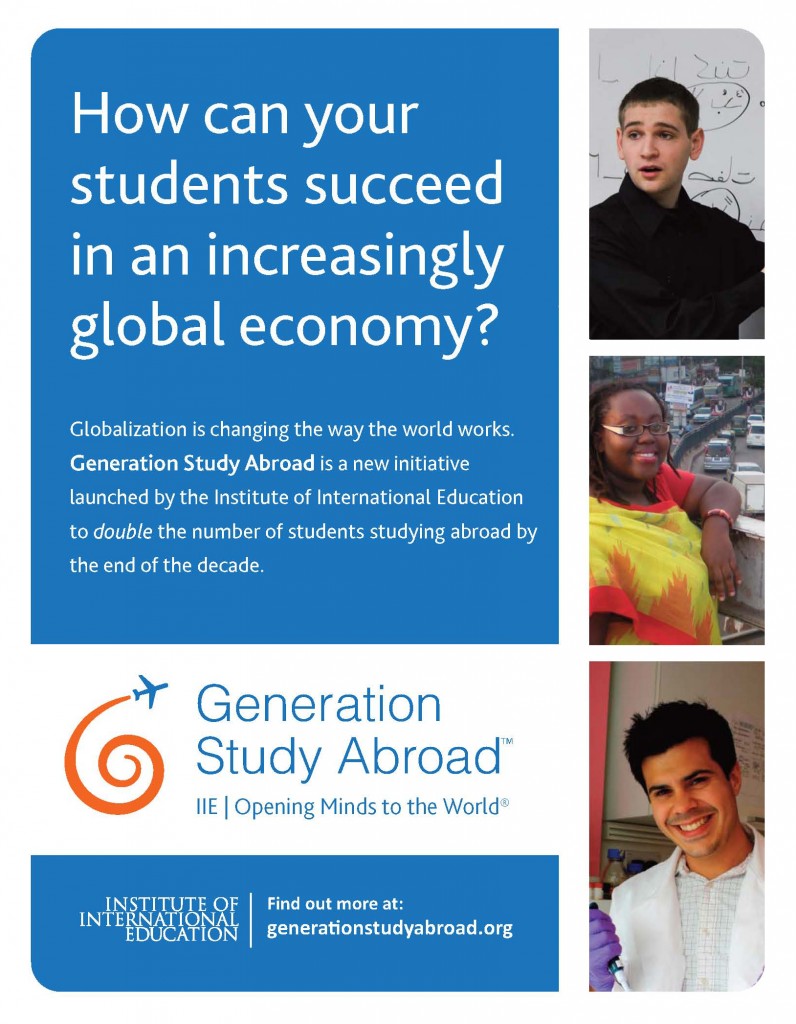 When I first heard about IIE’s new initiative “Generation Study Abroad”, my knee jerk reaction was to let out a rather large sigh. The subtitle of this new endeavor is “Doubling the number of U.S. students who study abroad.” Once again, our field was harping on sending MORE! MORE! MORE! students abroad. It appeared that the initial message was about numbers, not about the quality of the academic experience and structured, careful positioning of cross-cultural encounters to increase awareness of the value of intercultural competency.
When I first heard about IIE’s new initiative “Generation Study Abroad”, my knee jerk reaction was to let out a rather large sigh. The subtitle of this new endeavor is “Doubling the number of U.S. students who study abroad.” Once again, our field was harping on sending MORE! MORE! MORE! students abroad. It appeared that the initial message was about numbers, not about the quality of the academic experience and structured, careful positioning of cross-cultural encounters to increase awareness of the value of intercultural competency.
I was also troubled because there was also language around MORE students going abroad as part of the higher ed push for career opportunities due to increased globalization. I felt that this bold program was missing the opportunity to inspire with so many of the other aspects of what we can learn from crossing cultures – such as who we impact, how we change, and how we can take the learning back home to our local communities to affect social change.
My initial read of “Generation Study Abroad” was via an email to the Secuss-L listserv. It left me with the impression that there wasn’t a serious focus on host communities. How does sending more and more US Americans abroad impact the locals who aren’t necessarily inviting us into their communities? Besides the economic gain (short or long term), how do locals feel about an increase in students rolling through their communities and possibly invading their space for Facebook photo moments (without permission), “partying” or being less than respectful about resource usage?
These general concerns should be no surprise to anyone who knows about the work that we do here at Melibee Global. They are what drove me and the Melibee team, in partnership with Amizade, to spearhead a project called Better Abroad in 2013. (Coincidentally, Better Abroad – a volunteer project – was recently nominated for an innovation award by GoAbroad.)
With concerns in mind, I contacted Daniel Obst, Deputy Vice President, International Partnerships of IIE. Being from New York and having worked in international education for many years, I am usually impressed with IIE’s commitment to excellence in international education. Therefore, I wanted to ask Daniel, directly, about what I felt was missing the mark in this case. (Keep in mind that as a business owner who does not send students abroad and who has no affiliation with a university or third party programs, I have the luxury of asking those hard questions! )
Daniel was wonderfully receptive and confidently able to address my concerns with an open heart. We quickly agreed on the utopian version of education abroad – that it “changing lives” and is a positive experience for everyone when done well – in terms of program design and attention to partnership with the local community.
I shared my concerns about the numbers game I see in higher education, the lack of resources in the organizations that they are targeting, and concerns about the host community impact (often over the “needs” of students and schools to have these experiences to support future job hunting.)
Daniel explained that “each institution that joins the initiative sets their own priorities for how to accomplish their goals” and that “the initiative is not about sending 300,000 more students on short group trips abroad.” He addressed my concerns about attracting host organizations and governments to the discussion and that the growth is not only encouraged in faculty led academic programs, but semester and year abroad goals too. That makes sense, in theory, but with the growth in short term programs that often resemble tours, I still do have my concerns. As of the time of publication, IIE had eight university partners abroad signed up for the initiative, although Daniel assured me that more were coming on board and that seeking approval internally took time – which is totally understandable as higher ed often moves at a snail’s pace.
If you know anything about Melibee Global and Better Abroad, you already know that program design is a key component of how and what students learn across cultures. Therefore, one of my greatest issues with this initiative is that it encourages sending more people – including faculty who may be discipline experts but know little to nothing about how to process cross-cultural incidents or how to effectively partner with locals in a host community – and this can be highly damaging to students’ understanding of culture and self-awareness.
Daniel indicated that IIE, in partnership with The Forum on Education Abroad, were providing ongoing training opportunities for anyone participating in this initiative. My next logical question was whether an organization had to pay to be a member of the Forum to participate in these sessions, and I was pleased to hear that the answer is no. Additionally, Daniel mentioned that they hope to have a face to face gathering with participants of this initiative in 2015 to share best practices.
After speaking with Daniel, I have a much better understanding where they are leading in this area and that some of the goals extend well beyond the numbers. I do wish that the initiative had a different subheading or at least included some reference to quality of interaction across cultures as the lead. The initial message still rings poorly (at least to me) because it can lead people to believe that we are in some numbers race that is associated with getting jobs ahead of others. It is unfortunate, because the initiative is certainly well intended, requiring a Senior International Officer of each organization to sign off on supporting the initiative before being listed with IIE. (One at least hopes that there is some accountability in that case, as I have worked for schools that will sign on the dotted line and fail to deliver on the goods when needed because of budget cuts or a simple lack of understanding of the commitment of educating across cultures. )
The reality is that creating a new generation of study abroad isn’t a game of numbers or the influence of tenure. It is a serious endeavor that requires a community effort, across borders, to succeed. It is my hope that we continue, as a field, to ask these kind of hard questions in an effort to continue to elevate the dialogue about what messages we are sharing with the world about our goals to send more to others’ countries.
And so there are no misunderstandings, I do applaud IIE for re-addressing the issue of how few students in the US study abroad. This initiative aims to bring heightened awareness about the value and effort needed to effectively increase education abroad. However, equal effort in terms of training and administrative/faculty support needs to be REQUIRED of those who are sending people into this beautiful world of ours. This isn’t a competitive game of cranking out the mystical “global citizens” that our admissions offices like to market, or adding metrics to a report of how many people “got jobs” after graduation. This is diplomacy, cultural competency, sustainability, language, self-awareness, identity, perspective, etc in the making – and that is a tremendous responsibility that isn’t easily solved by “we sent 3% more students abroad this year.”
What are your thoughts about this topic? I’d love to hear your perspective! Please comment below – there is no need to register to do so and you may do so anonymously if you choose.
 About the Author: Missy Gluckmann is the founder of Melibee Global. She and her husband, Tony, lived in Ecuador for 2 months and returned “home” in late January 2014. You can learn more about why she built Melibee Global and her background here.
About the Author: Missy Gluckmann is the founder of Melibee Global. She and her husband, Tony, lived in Ecuador for 2 months and returned “home” in late January 2014. You can learn more about why she built Melibee Global and her background here.


I’m glad that you mentioned this issue. You mentioned a good point that short term study abroad programs resemble tours. I’d even amend that to even semester and year long programs do as well. I’m working on a study abroad accreditation that students could use to show employers just how in depth their study abroad program really is.
Many people see study abroad as a time to “get wild” abroad, and I want to make sure that the impact of study abroad isn’t watered down.
Thanks for your note Ellen! I’ve seen some incredible short term programs that really are about partnering with the local community – and some that resemble tourism over education. It so depends on the faculty member and ed abroad’s philosophy of ed abroad. One of the many reasons we created Better Abroad! Feel free to inbox me info about your tool for quality of experience at my email – info (at)melibeeglobal(dot)com.
Missy: Wonderful that you reached out to Dan and that he was forthcoming. Seems he addressed your very good questions – but I still remain somewhat skeptical about the renewed emphasis on numbers, whether with IIE or the White House regarding sending students to Latin America or to China. Every professional and every institution wants to see an increase in the number of students who have an international experience during their four years at college. No one would argue otherwise. However, I think the re-alignment of such experiences with the career development of students is not going away. It is not an either or proposition: go for personal enrichment vs. career skill-building. My writing and presentations on this subject do not make the case in this way.
I think it behooves campuses, as you say, to ramp up their international initiatives taking into account their readiness to support curricular integration and career planning. Sending more students abroad, absent adequate advising from all parties is not going to meet learning objectives, support student career development or enhance prospects for employability. If you want to see campus best advising practices, look for my new AIFS publication at https://www.aifsabroad.com/advisors/publications.asp
Daniel and I had a really honest and open conversation – I so appreciated it. The program has very good intentions and is definitely misunderstood by many. My main issue is the perception that it is about #s, when it is about so much more. I agree that objectives for academic programs won’t be met without proper training – of administrators AND faculty. Thanks for sharing this resource and for your comment Marty!